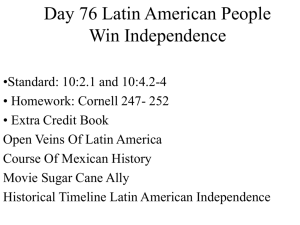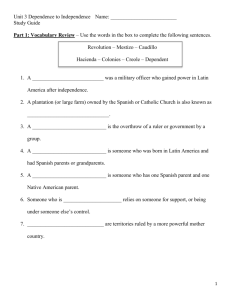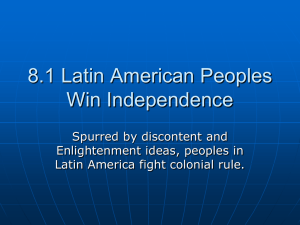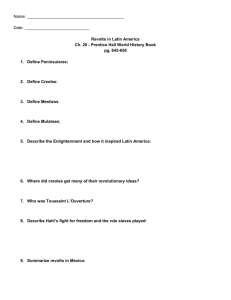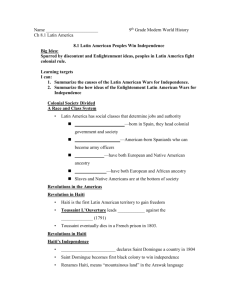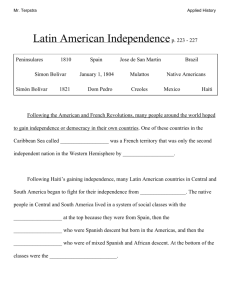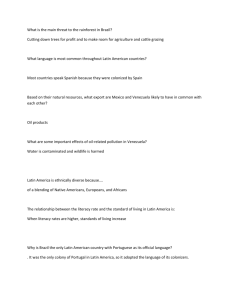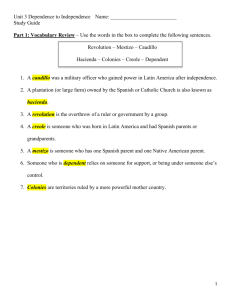Canada
advertisement
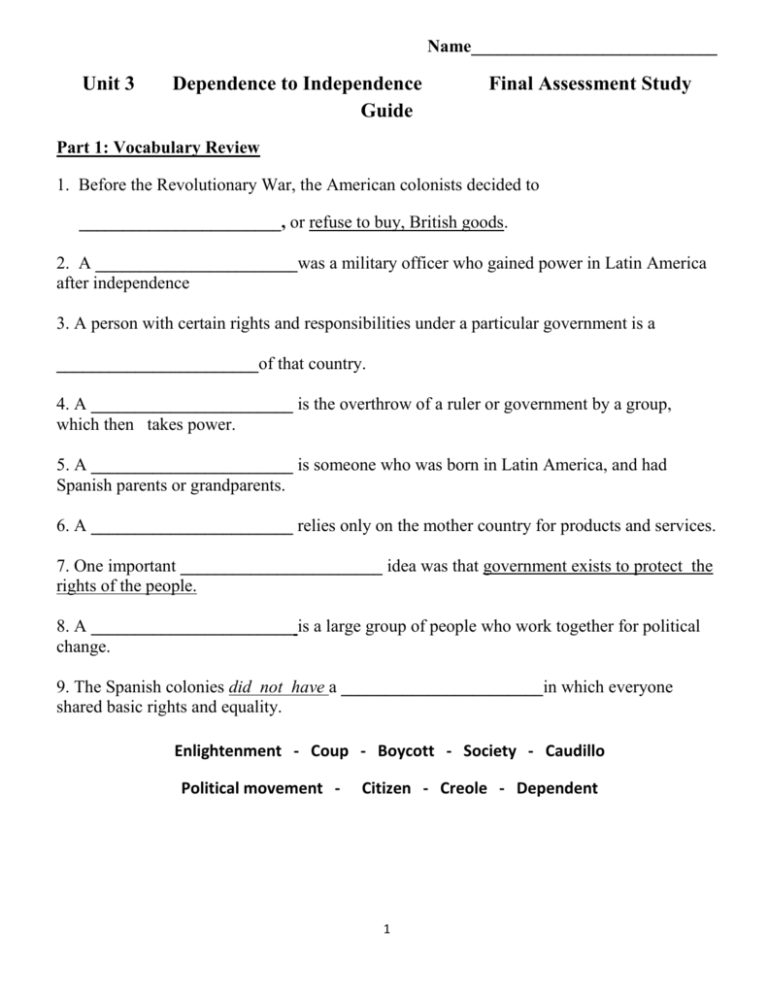
Name____________________________ Unit 3 Dependence to Independence Guide Final Assessment Study Part 1: Vocabulary Review 1. Before the Revolutionary War, the American colonists decided to _______________________, or refuse to buy, British goods. 2. A _______________________was a military officer who gained power in Latin America after independence 3. A person with certain rights and responsibilities under a particular government is a _______________________of that country. 4. A _______________________ is the overthrow of a ruler or government by a group, which then takes power. 5. A _______________________ is someone who was born in Latin America, and had Spanish parents or grandparents. 6. A _______________________ relies only on the mother country for products and services. 7. One important _______________________ idea was that government exists to protect the rights of the people. 8. A _______________________ is a large group of people who work together for political change. 9. The Spanish colonies did not have a _______________________in which everyone shared basic rights and equality. Enlightenment - Coup - Boycott - Society - Caudillo Political movement - Citizen - Creole - Dependent 1 Name____________________________ Part 2: Mexican Independence Timeline 1811: Father Hidalgo is captured and shot to death by a firing squad. 1808 1810 1810: Father Miguel Hidalgo calls for a revolt against the Spanish peninsulares 1812-1813 Father Jose Morelos takes over Mexico’s fight for independence from Spain. 1812 1814 1820-1821: Augustin de Iturbide guides Mexico to independence from Spain and declares himself emperor. 1816 1818 1815: Jose Morelos is executed by the Spanish for leading the rebellions. 1820 1822 1822: Santa Anna forces Iturbide out of Mexico and begins a new government based on a constitution Use the timeline as a guide to answer the following questions. 10. According to this time line, how long did it take for Mexico to gain independence? 11. How long did Jose Morelos fight for independence? 12. After Jose Morelos was executed, how long did it take for Iturbide to gain Mexico’s independence? 13. Why did Santa Anna force Augustin de Iturbide to resign as emperor? 2 Name____________________________ Part 3: Revolution and Independence Students will have questions from this section in all parts of the test Fill in the blank WITHOUT a wordbank! A. Haiti was the first European colony in Latin America to _________________________ from a country in Europe. In this case, the European country was France. B. Like most of the Latin American countries, Haiti’s independence was extremely violent. What made Haiti’s independence different was that it was executed by the ___________________________. ___________________________ was the slave who led the revolt. C. The Haitian Revolution IS or IS NOT (circle one) an example of how non-violence can result in positive change. However, _______________________ won its independence without using violence from Portugal and not from Spain. D. Brazil was once a colony of Portugal. In 1807, King John of Portugal escaped from the Napoleon’s invasion in Europe by staying in the New World, Brazil. Once Napoleon was conquered, he returned to ____________________, leaving his son, _______________________, in charge. E. Most countries of Latin America relied on some form of revolution and violence. However, ___________________________was not an example of a violent overthrow of government. F. Other than Brazil, Latin American countries were ruled by caudillos after independence. Caudillos did not care at all for the well-being of the people of their countries. The caudillos were concerned mainly with __________________________________. 3 Name____________________________ Part 4 - Open Ended Questions They will be worth 7 points each. One question will be based on comparing methods of gaining independence. Another question will be to explain why some countries were able to be successful while others were led to more violent leaders. Complete the following table by determining whether the country used violence or nonviolence to gain independence and the type of government that followed, either democracy or a dictatorship run by a caudillo. America Brazil Canada Haiti Mexico Venezuela Method of Leadership or Gaining Government Following Independence Independence Violent Democratic government The United States did not fall victim to violent overthrows or coups as was the case in most Latin American countries. Before, during and after the Revolutionary War (1775 - 83), American leaders banded together to work out the grievances of each colony; their needs and concerns, and by 1788, the colonies approved the framework of the government as the Constitution of the United States. The Founding Fathers also developed a Bill of Rights which addressed the rights/personal freedoms of the people. Due to the Constitution and the Bill of Rights, America had a successful democratic government after its revolution, whereas Latin American countries, save Brazil, struggled after their independence. *Canada was a Dominion of Great Britain, but was granted its own central democratic government. Canada developed for over a hundred years. They gained their independence from Great Britain through petition, unheard of in most Latin American countries. As a result of the British North American Act of 1867, Canada had its own central government. Latin America was often the heat of the moment and leadership was taken by the powerful with little regard for the people. Brazil was the notable exception as most newly formed independent governments of Latin America were taken over by corrupt caudillos. 4 Name____________________________ Part 5 - Map Skills: Use the map above to answer the next 5 questions. 20. Between which two lines of latitude do you find the island of Aruba (south central Caribbean Sea)? 21. Give the absolute location of San Juan, Puerto Rico? 22. Of Cuba, Puerto Rico and the Bahamas, the island(s) found furthest west? South? 23. Which country is north of Cuba? Name one country south of Aruba? 24. Name the island located at 24 degrees north latitude and 75 degrees west longitude. 5 Name____________________________ Part 6: Primary Source RASC Essay Question: Haitian Declaration of Independence “Citizens: It is not enough to have expelled the barbarians who have bloodied our land for two centuries. We must, with one last act of national authority, forever assure the empire of liberty in the country of our birth; we must take any hope of re-enslaving us away from the inhuman government that for so long kept us in the most humiliating conditions. In the end we must live independent or die. Independence or death... let these sacred words unite us and be the signal of battle and of our reunion.” ~Jean-Jaques Dessalines, Commander in Chief of Haiti, 1804. Respond to this quote by following the RASC model. Yous must CITE evidence from the text, and explain what it means and how it supports your answer. What is Dessalines saying to the people of Haiti? What is he telling them to do? 6
